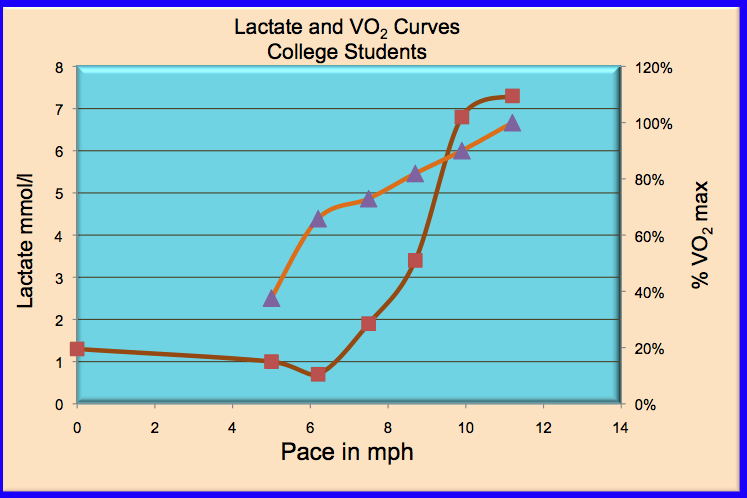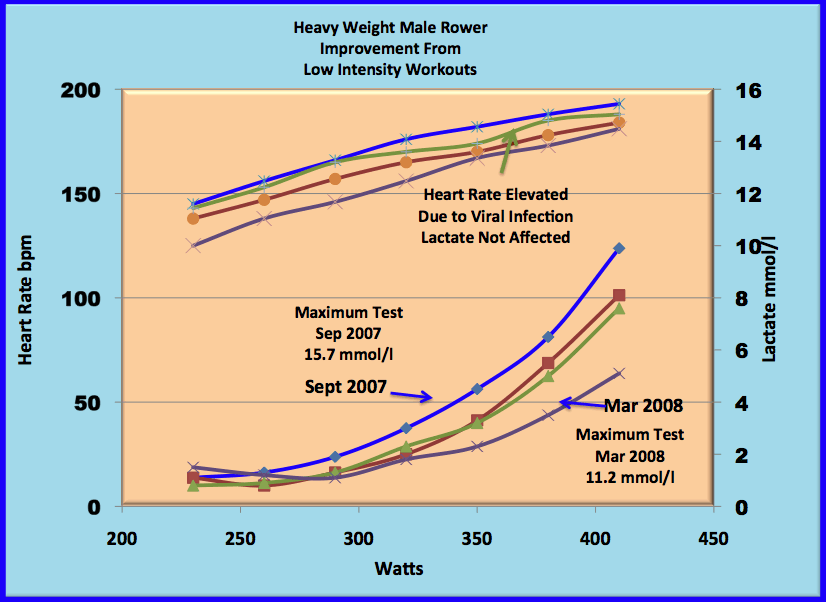Want to Run, Cycle, Swim Fast?
Exercise Physiologist Georgios Ziogas and his Lactate Scout show you how!
Dr. Ziogas is from Thessalonika in Greece. He works with hundreds of athletes that include triathletes, soccer players, swimmers, runners, cyclists and rowers. He has been using lactate testing for over 12 years to train these athletes. Dr. Ziogas uses the Lactate Scout for his testing and the following are several examples of his testing with different types and different levels of athletes.
Serious Triathlete
Here are the test results for a serious triathlete.
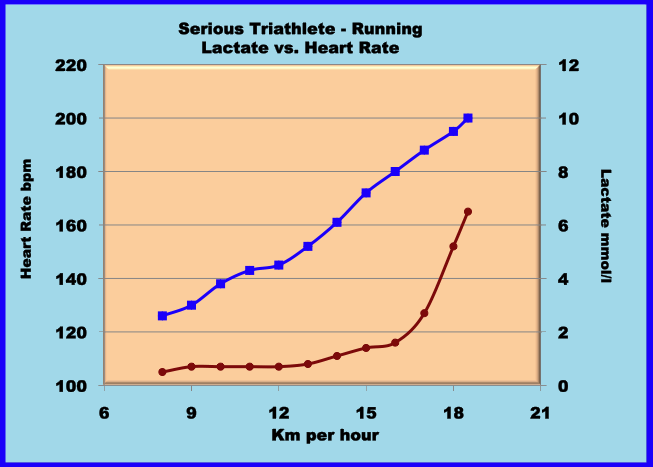
Dr. Ziogas prepared the following charts for this triathlete to help with his training. Notice for the long runs (14.8 km/hr.) and ultra long runs (12.5 km/hr ,) how the pace is very slow compared to the V4 pace (17.9 km/hr.) The ultra long runs are just 70% of the V4 pace.
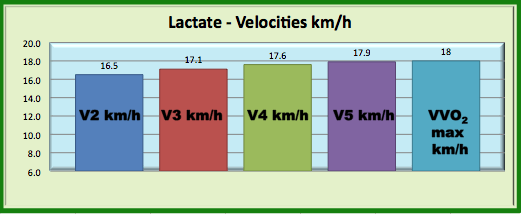
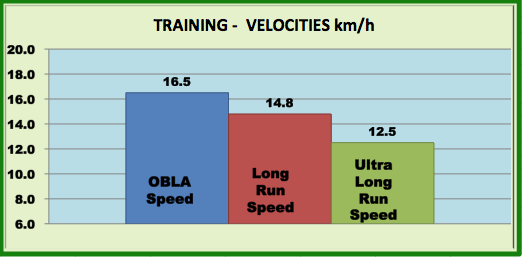
For more specific paces and heart rates the athlete will use the following chart.
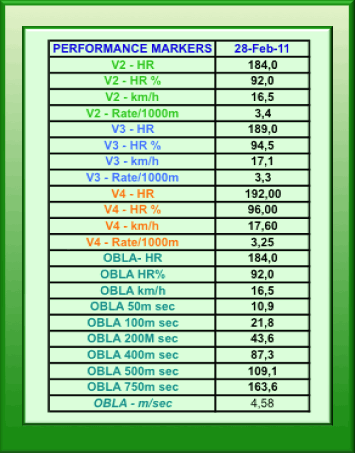
Recreational Marathoner
Here is a similar approach but for a recreational marathoner.
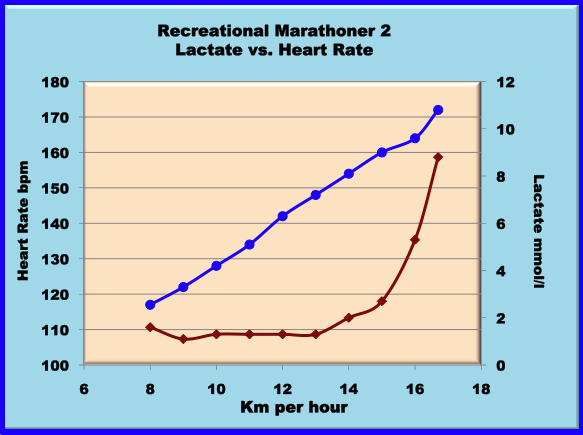
Dr. Ziogas prepared the following charts for this triathlete to help with his training. First a chart just using running speeds.

Next a chart just using heart rates.
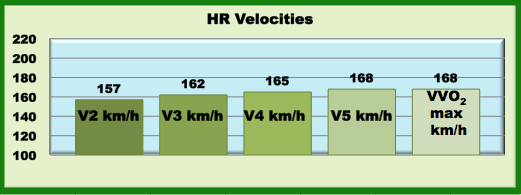
And a chart with recommended training velocities.

Young Cyclist
Here is a lactate curve for a young cyclist, just 18 years old.
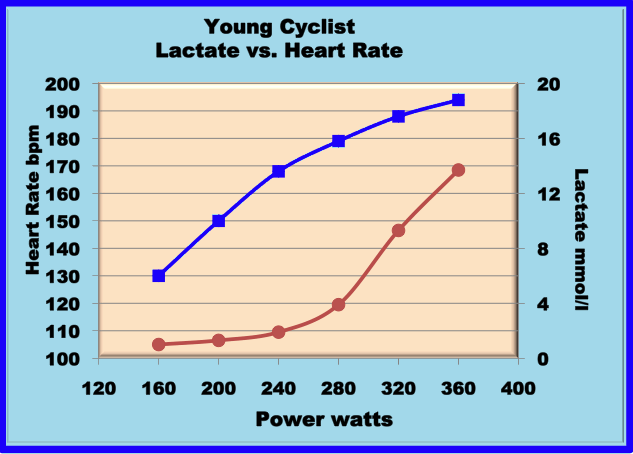
Dr. Ziogas prepared the following charts for this cyclist to help with his training. First a chart just using powers at different lactate levels.
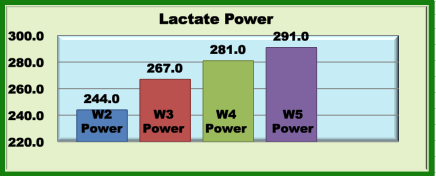
Here is a chart using heart rates to guide the cyclist during his training to replicate the different lactate/power relationships.

Finally, a detailed chart of various parameters to use while training and to compare to previous workouts based on a test 6 months prior. Notice the dramatic improvement in this young athlete.
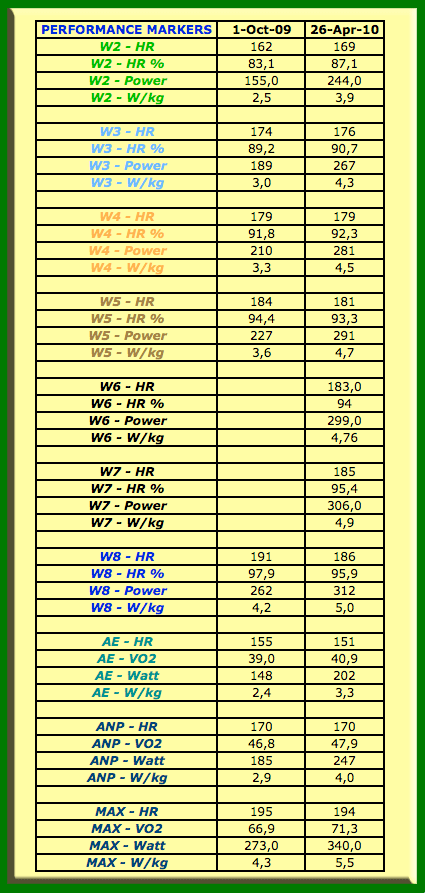
Young Soccer Player
Here is a series of lactate curves for a young soccer player. This plots the testing over a two year period.

Dr. Ziogas prepared the following charts for this cyclist to help with his training. Because this athlete has been tested several times it is best to be able to see the progress over time. First a chart that shows the V2 over time. Because of the nature of the testing, may not be the best measure to track.

Then a chart that shows the V4 over time which shows the progression from one year to the next.

These tests and the consequent analysis provide the athlete with concrete recommendations for his or her training. They then can be assessed at a future time and the athlete's training can be assessed to see if it is producing the desired results. As the coach compares each of his athletes with pass performances by this particular athlete and others he or she has coached, clearer training strategies arise and the chance of making a mistake becomes less. The approach solves problems before they arise by not letting them arise.
Want to Row Fast?
Coach
Andy Medcalf and his Lactate Scout show you how!
A top rowing coach in Philadelphia, Andy Medcalf, introduced himself to lactate testing in 2004 and used his son, Sean, as his first test case after Sean started rowing at age 14. The result was that Sean won the Stotesbury single sculls two years later which made him the high school champion of North America. Andy's secret was using Jan Olbrecht's training techniques adapted to rowing and lactate testing. Andy slowed down most of his rowers and they responded by rowing faster and feeling much more refreshed. They didn't hate practice and certainly enjoyed the less burdensome workouts as well as the success. And he made sure his program was working with periodic lactate testing.
Andy who is a Brit, has moved back to the UK and now works with British rowers. He has started a consulting business and has expanded beyond rowing with what he has learned using Olbrecht's training philosophy and lactate testing. Andy discusses on his web site, Competitive Edge Sports Ltd, the types of help he can provide based on what he has learned in the last 7 years using this new training approach.
Olbrecht has found out that the more elite the athlete is, the higher will be their vulnerability to over training. Thus, any increase in the training volume that is necessary for the continued success of these athletes must also ensure that the bulk of this increased volume of training must be at low levels. It does not mean that all training is at low levels, a substantial part is still very intense. It means that a lot of the increase must be focused on regenerative workouts. Here are three success stories on how lactate testing and and an emphasis on low level workouts helped Andy's athletes.
A Relatively Unknown Rower Enjoys World Class Success
Andy took a novice sculler and had him in the finals of the World Championships in just over a year. This light weight sweeps rower had to learn technique as well progress physiologically. Andy knew what to do in both areas because he knew he had a talented athlete. By June of 2008 this rower was generating 350 w at 4 mmol/l. The US World trials were in Late July and the World Championships were a little than a month later. A lactate test of the rower just after the trials which he won revealed the deterioration in aerobic capacity from the tough two months of racing culminating in the trials. Andy's reaction was not to panic but to go ahead with what had gotten the rower to this point of representing the US at the World Championships. He had the rower do just regenerative sets for the next three weeks. Long slow rowing with little intense work built back the aerobic capacity. The results, the rower made the finals of the World Championships and finished 6th. Not bad for someone who a year earlier had sculled only occasionally before.
Here are Andy's comments from his web site, Competitive Edge Sports Ltd.
"Before the US trials he could produce 350W at 4mM lactate at race weight of 71kg, which is excellent. After trials he had 3 days off and then 2 easy days followed by a lactate step test. Much to my surprise, even taking into account 90 degree+ temperatures, he could not complete the test and his curve had moved dramatically to the left producing less than 325W at 4mM. He was put on a recovery programme of mostly regeneration with his pulse at 110-115bpm. A week later he was lactate tested again. Although the lactate readings were no better, he was much fresher. We were in Munich for over a week before racing started and most of his training consisted of rowing with his pulse at 110-115bpm. In his heat of 6 he was seeded as the lowest seed and came up against the world bronze medallist of the year before. He blasted off the start and eventually won the heat. This in itself was a remarkable performance for such a raw talent. So, despite the fact that he had done almost no hard training for 3 weeks he was faster in Munich than ever before. Training scientifically and allowing for full recovery works."
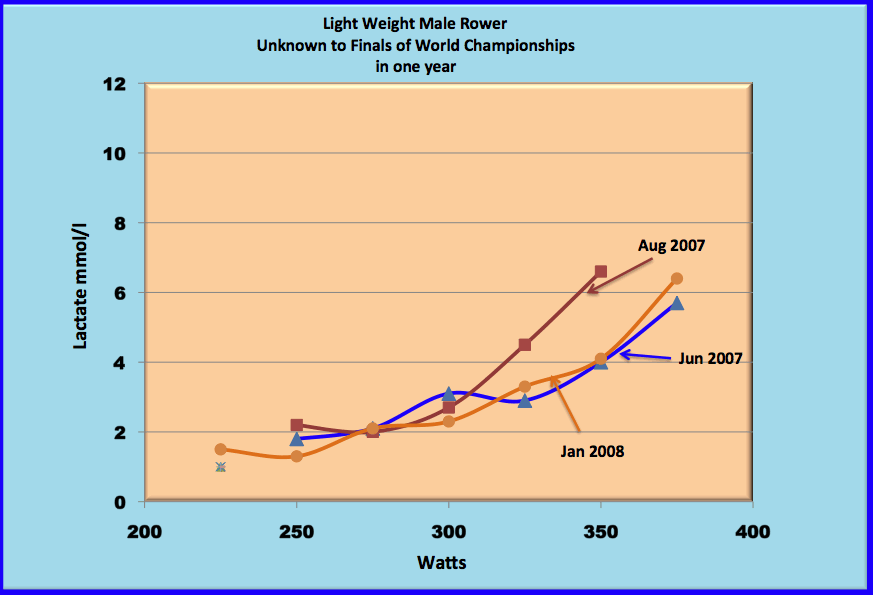
A Triathlete Turns Rower
Andy is great with new people. The following female ex triathlete never rowed before and it took only 20 months to get her into world class regattas and she was battling various illnesses for part of the time. She was an American graduate student in London when Andy met her. Not only had she never rowed before but she produced lactate like she was a world class sprinter. Which means her aerobic capacity must be high but not high enough to succeed with world class rowers. The chart below shows her progress over a year and a half as she learned her new sport. The interesting thing is not that these curves are good for a new rower but that the maximum test was so high which indicated even brighter things as this was brought down. As future training drives this down the lactate curves will move to the right even more just because of a change in anaerobic capacity.
Here are Andy's comments from his web site, Competitive Edge Sports Ltd.
"She began rowing in October 2008. 5ft 7ins and about 62kg and age 23. From Denver, Colorado she had been a competitive triathlete. She was quickly identified by me as someone with some potential and promoted to the elite group at the University of London where I took her under my wing. Her initial lactate step test was a big surprise for someone you would think had great endurance. She was a “lactate producing machine”. The diagnosis was that her anaerobic system was far too powerful for her aerobic system leading to very high levels of lactate. The solution was for her to do most of her training at 1.5mM lactate or under with the goal of strengthening her aerobic system. By avoiding any form of high power work through the winter training period as much as possible we also were attempting to suppress her anaerobic system. Despite repeated health set backs through the 2010 campaign, carbon monoxide poisoning and glandular fever, we were able to keep her moving forward physiologically. Repeat lactate analysis demonstrated her continuing evolution. In 2010 she won the senior lightweight single at Women’s Henley, represented the US at the World University Games and was very near selection for the senior US team at the World Championships. All this after only rowing for 2 years."
A Male Heavy weight Rower
Not everybody Andy gets is new to the sport or the event. The following is an athlete that was aspiring to a national team. The chart below shows his progress over a six month period. Of particular interest is the interaction of lactate, heart rate and illness. The green lines represent a test done in January of 2008 when the athlete had a bad cold. Without the lactate information a coach might have completely mis read the situation.
Here are Andy's comments from his web site, Competitive Edge Sports Ltd.
"These data were obtained from one heavyweight male rower over a period of 6 months. The bottom set of curves represent lactate concentrations and the top set corresponding heart rate. The lactate curves show an ideal response to training with the curves moving steadily to the right. He was able to increase his power output at 4mM lactate from about 340W to about 390W during the 6 month period. 340W at 4mM is not sufficient for an aspiring international rower but 390W provides great potential. Also note that the heart rate has also moved to the right; less beats per minute were required to produce a given amount of power. For the test of 26/1/08 he had a cold and this clearly affected his heart rate confirming other data we have obtained that illness will increase heart rate at a given work load but will have less effect on lactate.
Another important point is the relative power of the anaerobic system for endurance athletes as well as sprinters. The commonly held belief is that the more power produced at a given lactic acid level the better. This premise needs to be re-considered, especially during the major taper and lead in to the major competition. This is because I and others have observed deteriorating lactate data for athletes who are at the height of their powers just before major competition. The explanation is that during the build up to such competition more speed work with less training volume is done leading to a strengthening anaerobic system. This means more lactate is produced which reduces power produced at a given lactate level. For further information on this point refer to “The Science of Winning” written by Jan Olbrecht.
Measuring College Athletes with the Lactate Scout portable lactate analyzer
A college researcher was trying to assess the effect of a nutritional sentiment on various physiological properties including lactate metabolism. To assess this he recruited college athletes and used the Lactate Scout to measure lactate. The following charts are the results of this testing used to measure lactate. We have presented 10 examples to show what one might expect using a graded exercise test (GXT) by a trained researcher that measured both lactate and VO2.
In each example the researcher measured a resting lactate which is represented by the measurement at zero and the next measurement was at a low pace on the treadmill, somewhere near 5 miles per hour or a 12 minute mile pace. The athlete ran for 3 minutes and then a lactate reading was taken and the speed increased. Oxygen was taken continuously. You will notice some of the little imperfections that will take place when using portable lactate testing instruments and also you will notice some imperfections in the VO2 measurements.
Athlete 1
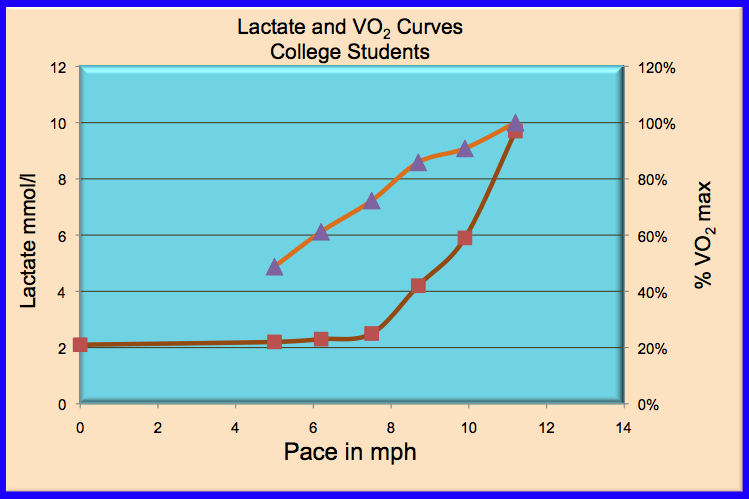
Athlete 2
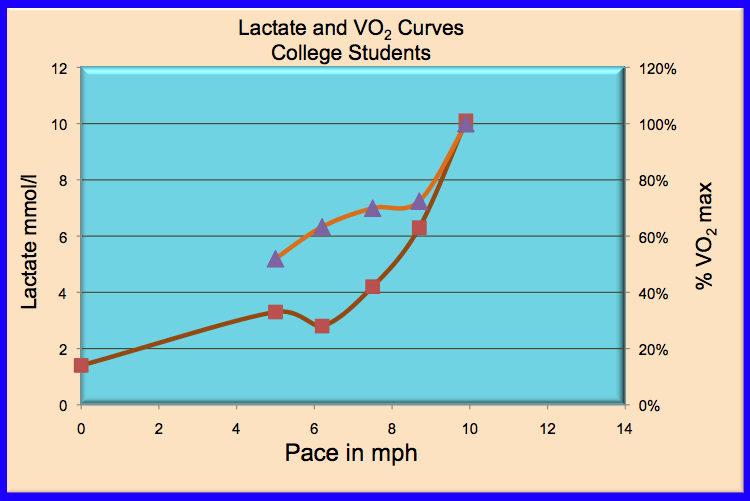
Athlete 3

Athlete 4
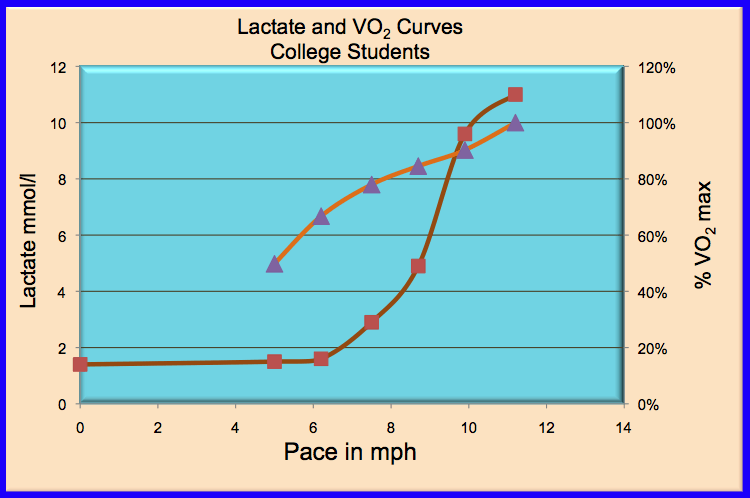
Athlete 5
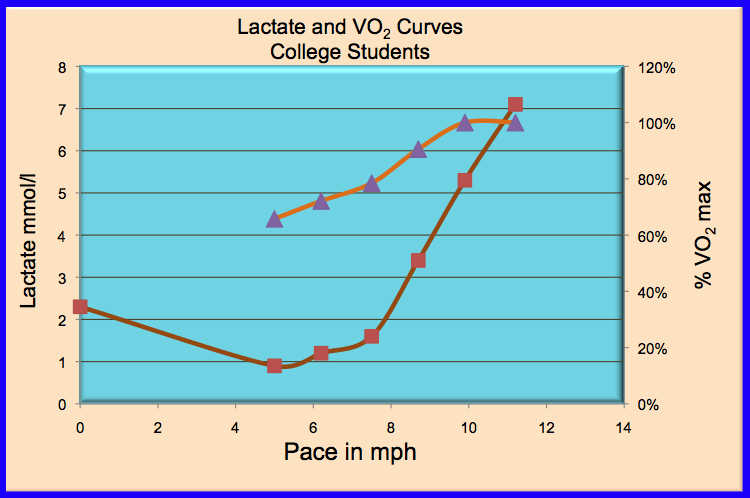
Athlete 6

Athlete 7
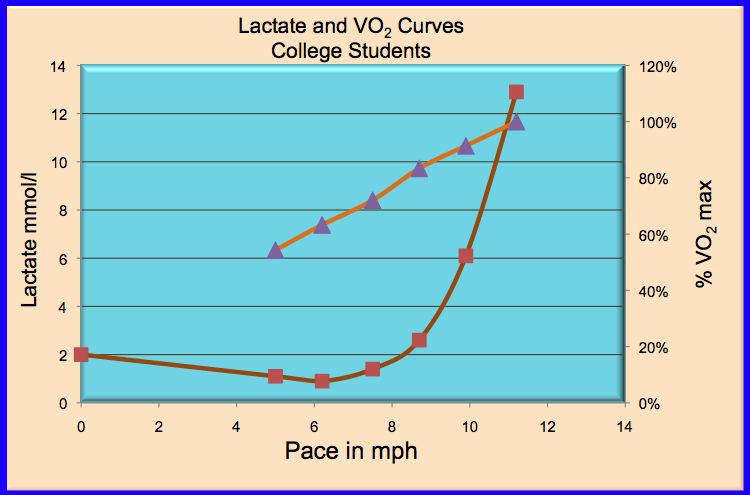
Athlete 8
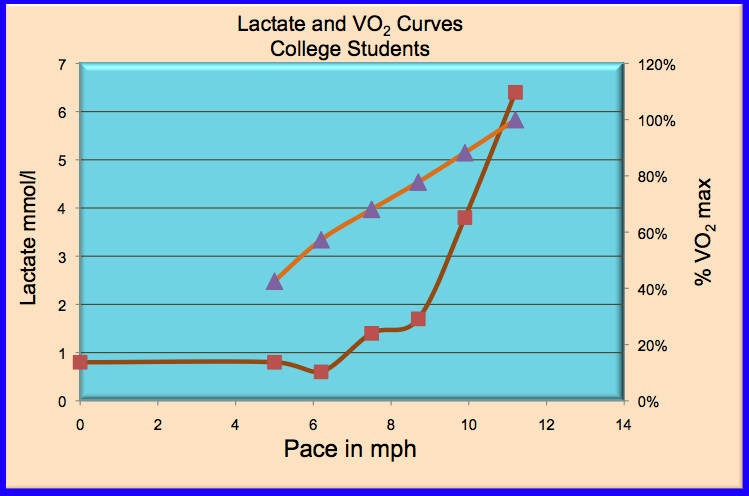
Athlete 9

Athlete 10
